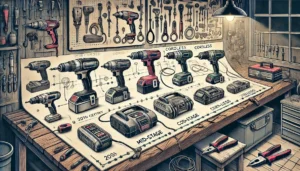The right tools are needed for any technician’s daily activities in different industries. The right set of tools increases productivity and ensures safety while working. Here is a checklist of a few hand tools that every technician should have:
1. Screewdrivers
Every technician should have a well rounded screwdriver set, which should include:
- Flathead Screwdriver: Best for driving screws that have a straight flat blade opening.
- Phillips Head Screwdriver: Designed to be used on screws that have x shaped openings.
- Precision Screwdrivers: Meant for more delicate tasks, such as electronics repairs as they are available in much smaller sizes.
2. Pliers
Pliers are required for gripping, bending and tasks that involve cutting. Some types are:
- Needle Nose Pliers: Suitable for small components and works well in tight spaces.
- Lineman’s Pliers: Can easily be used for wire cutting and twisting as they are heavy duty pliers.
- Channel Lock Pliers: Can be used for virtually anything as they can grip on to an array of different sizes.
Every type of pliers has a certain purpose and measures how much flexibility a technician has for dealing with different tasks.
3. Wrenches
For loosening or tightening bolts and nuts, a comprehensive set of wrenches will suffice. Important sets of wrenches include the following:
- Combination Wrenches: These wrenches come with an open end on one side and a box-end on the opposite side. This greatly enhances versatility.
- Adjustable Wrenches: These wrenches come with adjustable heads that are able to accommodate a variety of bolt and nuts sizes.
- Socket Wrenches: These wrenches are used alongside interchangeable sockets and are ideal for tasks that need multiple sizes.
Investing in quality tools guarantees endurance alongside dependable performance during use.
4. Hammers
Permitting the infusion of nails, fitting of different parts, and breaking certain objects, hammers are an important tool. Some common types of hammers include the following:
- Claw Hammer: This is the standard hammer with a flat face that is used to drive in nails while the claw is used to remove nails.
- Ball-Peen Hammer: These hammers have a rounded end on the side opposite the flat face, which is useful to people working in the metal crafting industry.
- Mallet: This hammer comes with a soft face made of rubber or wood and is used for hitting with the intention of not marrying surfaces.
To get ideal results with the desired task, the correct type and weight of a hammer need to be selected.
5. Utility Knife
For cutting cardboard, plastic, or insulation, a sharp utility knife is crucial. You should select a model with a securely locking blade and replaceable blades to guarantee safety when the knife is not in use.
6. Tape Measure
Certain technical areas require precise measurements to be taken. For taking precise measurements, having a relatively long tape measure with clear markings and a sturdy blade is important.
7. Level
It is important to ensure that something is installed and oriented at a right angle to Earth’s surface. A level helps achieve correct alignment in numerous tasks or projects.
8. Multimeter
For many people, including technicians in the field who are dealing with anything electrical, measuring voltage, current, and resistance is a necessity. This tool is also particularly useful for electrical maintenance and safety checks.
9. Wire Strippers
Usually employed for the relatively safe removal of wire insulations, wire strippers are particularly useful in electrical works and are highly effective in ensuring that the conductor is not damaged.
10. Flashlight
When fulfilling a task or project which requires the use and application of a light source, the task must be done in a manner that ensures maximum safety and visibility and a reliable and sturdy flashlight allows one to do so.
11. Adjustable Spanner
Commonly known as crescent wrenches, these types of tools can be used without the requirement of having any type of specific nut or bolt and are therefore highly versatile.
12. Allen Wrenches (Hex Keys)
Commonly used in industrial machines and furniture, these fasteners are simple and very efficient to use. The socket has a hexagonally shaped tubular structure that serves the purpose of receiving screws or bolts.
13. Soldering Iron
Joining parts in electronics and metalworking would require a tool in the form of a soldering iron, particularly when precision is of utmost importance.
14. Pry Bar
A pry bar is a very useful tool because of its capability to assist in lifting items, removing nails, and even lifting apart materials.
15. Safety Gear
While not a hand tool, personal protective equipment (PPE) is essential for technician safety. This includes:
- Safety Glasses: Safeguard your eyes from chemicals and debris.
- Gloves: Protect hands from cuts, burns, and electrical injuries.
- Hearing Protection: Essential in high-noise areas where hearing might be compromised.
The tools mentioned above greatly increase productivity when combined with the necessary protective gear and its careful maintenance. Periodically checking the tools will keep them functional longer and cleaning, sharpening, or putting in new components will assist in keeping them effective.
Utilization of these essential hand tools while following proper maintenance techniques will guarantee effectiveness in all technical undertakings and maintain safety.










